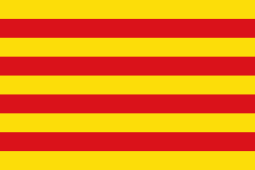
Back سينيارا Arabic Sanyera Azerbaijani Саньера Byelorussian Senyera Reial Catalan Senjera Esperanto Señera Spanish Senyera Basque Senyera Galician Senjera Croatian Senyera Hungarian
 | |
| Senyera | |
| Use | Civil and state flag |
|---|---|
| Proportion | 2:3 |
| Adopted | 25 May 1933 |
| Design | Nine alternating horizontal stripes of yellow and red. |
The Senyera[a] is a vexillological symbol based on the coat of arms of the Crown of Aragon, which consists of four red stripes on a yellow field. This coat of arms, often called bars of Aragon,[1] or simply "the four bars", historically represented the King of the Crown of Aragon.
The senyera pattern is currently in the flag of four Spanish autonomous communities (Aragon, Catalonia, the Balearic Islands, and the Valencian Community), and is the flag of the historically Catalan-speaking city of Alghero (Catalan: L'Alguer) in Sardinia, Italy. It is also used on the coat of arms of Spain, the coat of arms of the Pyrénées-Orientales department and of Provence-Alpes-Côte d'Azur, the flag of Roussillon, Capcir, Vallespir, and Provence in France, on the coat of arms of Andorra, and on the local flags of many municipalities belonging to these territories. The Senyera (sometimes together with the flag of Andorra) [citation needed] is also used informally in Catalonia to represent the Catalan language.
It is also a synonym (in Catalan Senyal Reial or Senyera and old Spanish Señal Real or Señera) for Royal Flag, although the word normally refers to the Aragonese and Catalan flags. Also in Aragonese, it is usually referred to as O Sinyal d'Aragón, i.e. "The Sign of Aragón".
Cite error: There are <ref group=lower-alpha> tags or {{efn}} templates on this page, but the references will not show without a {{reflist|group=lower-alpha}} template or {{notelist}} template (see the help page).